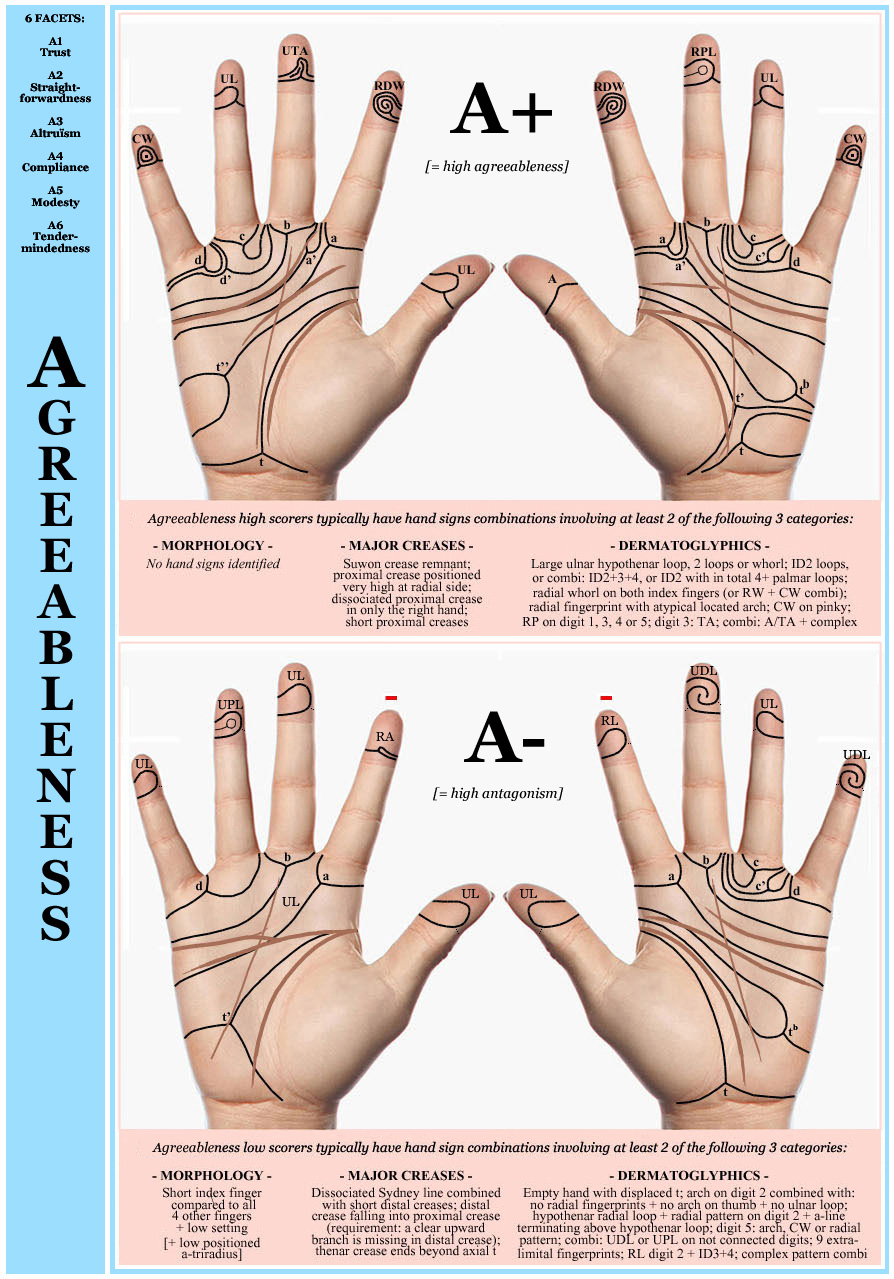|
- Publication date: march 7, 2017 (last update: may 23, 2017) - Hand Constellations in
|
|
|
Suwon remnants & hypothenar ulnar/double loops and whorls bare significance
for high scorers on the Big Five personality dimension Agreeableness!
A detailed assessment of the hands of 66 high scorers & 35 low scorers on the Big Five personality dimension Agreeableness has pointed out that the following two hand signs bare very high significance for high scorers (A+):
• A+ hand sign a: Suwon remnants [16 out of 66 A+ scorers (= 24,2%), 0 out 35 A- scorers (= 0,0%)];
• A+ hand sign b: Hypothenar whorls, double- & ulnar loops [16 out of 66 A+ scorers (= 24,2%), 0 out 35 A- scorers (= 0,0%)].
Combining these two hand signs accounts for 29 out of 66 A+ scorers (= 43,9%); a description for each of both hand signs is presented below:
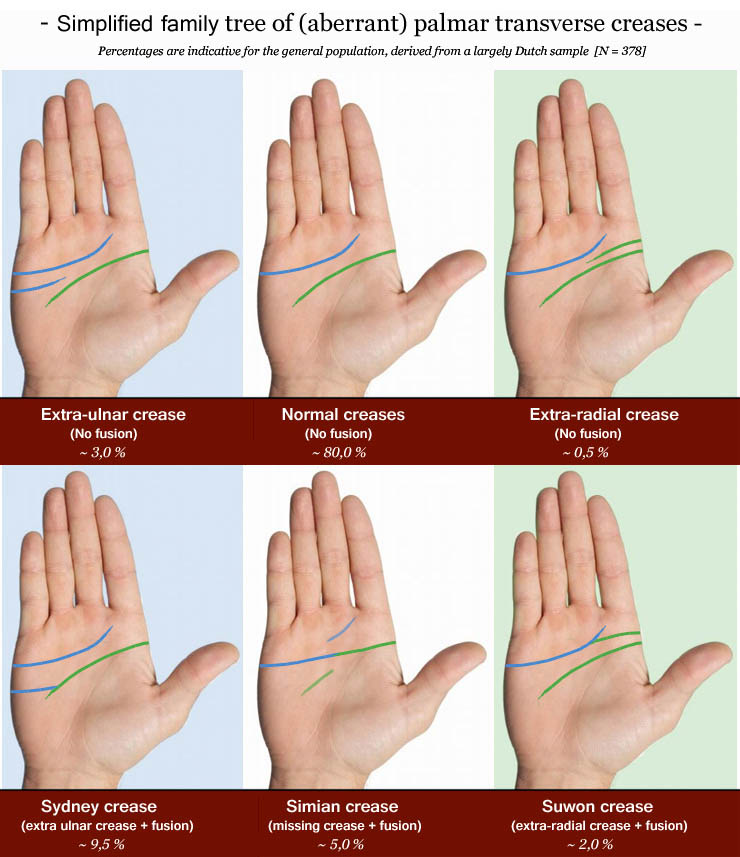
• A+ hand sign a: Suwon remnants:
The concept of the so-called Suwon crease was introduced in a 2010 article titled 'Improved Analysis of Palm Creases', presented by Korean researchers who mapped 3216 volunteers who resided in Suwon (= the capital of the most populous province in South Korea, which surrounds Seoul). The Suwon crease was described by the Korean researchers as follows: "Suwon crease (D): II and III meet accompanied by accessory II" (see picture below).

In the present study a phenomenon was found which can be described to be between the concept of Suwon creases and extra-radial creases.
At least 3 out of 5 of the following criteria are required to be present in order to allow a hand to score for the presence of a 'Suwon remnant' (this implicates that the presence of a full Suwon crease involving all 5 criteria is not required here, the criteria for a 'Suwon remnant' are slightly different from the Suwon crease itself!):
- Suwon remnant criterium 1: presence of a major crease structure that can serve as the presence of a 2nd proximal transverse crease [head line] located in the upper half of the zone between the thenar crease [life line] and the a-triradius [palmar triradius below the index finger], directed slightly upward towards the thumb side;
- Suwon remnant criterium 2: structure requires to have have enough length: in case of a construction that reminds of a splitting distal transverse crease [heart line] the remnant is required to be longer than the other (upward) branch, and it must reach out beyond the a-triradius;
- Suwon remnant criterium 3: radial side of structure is directed at the zone between the thenar crease and a-triradius, but it does not connected with the life line or other head line (the 2nd head line is required to resemble the concept of a dissociated proximal transverse crease);
- Suwon remnant criterium 4: structure does not concern a line that has a connection with palmar zone above the distal transverse crease below the middle- or ring finger;
- Suwon remnant criterium 5: structure does not look like a normal splitting distal transverse crease.
Additionally, it is also significant to report that in all A+ scorers with a 'Suwon remnant', the featured proximal tranverse crease does not have long length; in the continuation of this article the presence of a short head line in both hands also bares significance (see A+ hand sign c).
Finally, a proper understanding regarding the fundamental principles involved with the concept of the Suwon line is presented in the picture below (e.g pictures describes the fundamental difference compared with the concept of a simian line and Sydney line):
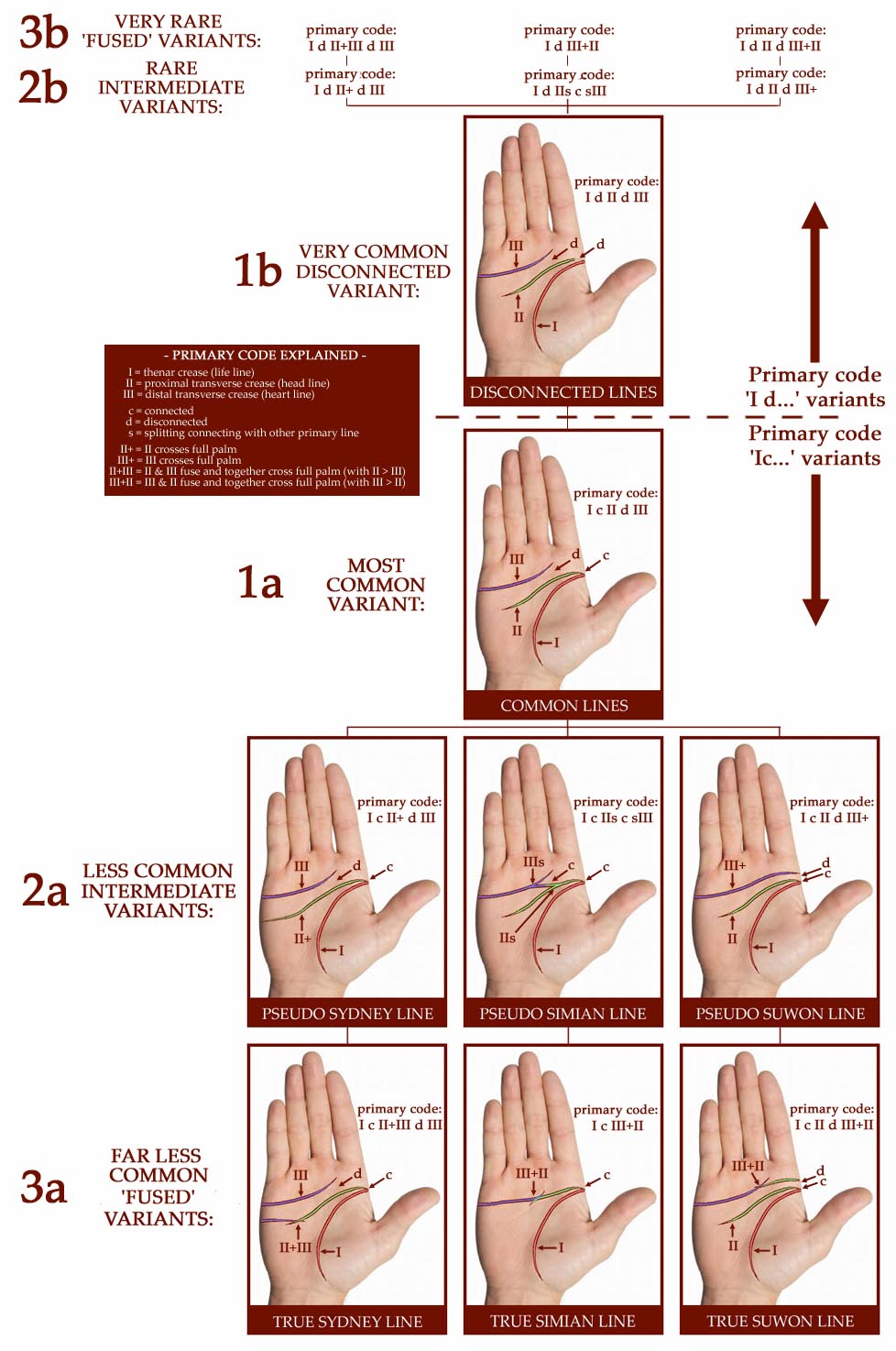
• A+ hand sign b: Hypothenar ulnar loops [LU], double loops [WS] & whorls [W]:
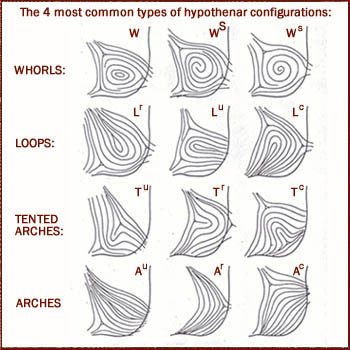 Hypothenar whorls [= whorls on the mount of moon] and hypothenar double loops are not present in any of the Agreeableness low scorers (A-). For the hypothenar ulnar loops an extra requirement was made involving the distance between the two hypothenar triraddi, the requirement was set at a distance larger than 1 cm - so the ulnar loop is required to be considerably 'large'. None of the Agreeableness low scorers (A-) clearly met this criterium.
Hypothenar whorls [= whorls on the mount of moon] and hypothenar double loops are not present in any of the Agreeableness low scorers (A-). For the hypothenar ulnar loops an extra requirement was made involving the distance between the two hypothenar triraddi, the requirement was set at a distance larger than 1 cm - so the ulnar loop is required to be considerably 'large'. None of the Agreeableness low scorers (A-) clearly met this criterium.
The results for the Agreeableness high scorers (A+) and low scorers (A-) are as follows:
- Hypothenar whorls (b1): 3 out of 66 A+ scorers (= 4,5%), 0 out 35 A- scorers (= 0,0%);
- Hypothenar double loops (b2): 4 out of 66 A+ scorers (= 6,1%), 0 out 35 A- scorers (= 0,0%);
- Hypothenar 'large' ulnar loops (b3): 9 out of 66 A+ scorers (= 13,5%), 0 out 35 A- scorers (= 0,0%).
Similarity between Suwon remnants & extraordinary dissociated lower transverse creases, also with distal directed quadrangle assymetries!
A detailed assessment of the hands of 66 high scorers & 35 low scorers on the Big Five personality dimension Agreeableness has pointed out that two aspects involving the head line also bare significance for high scorers (A+):
• A+ hand sign c: Short proximal transverse crease both hands [5 out of 66 A+ scorers (= 7,6%), 0 out 35 A- scorers (= 0,0%)];
• A+ hand sign d: Proximal tranverse crease approaches a-triradius [4 out of 66 A+ scorers (= 6,1%), 0 out 35 A- scorers (= 0,0%)].
Both of the signs can indirectly be recognized to represent a principle that shows a parallel with the finding reported for the 'Suwon remnant' (A+ hand sign a).
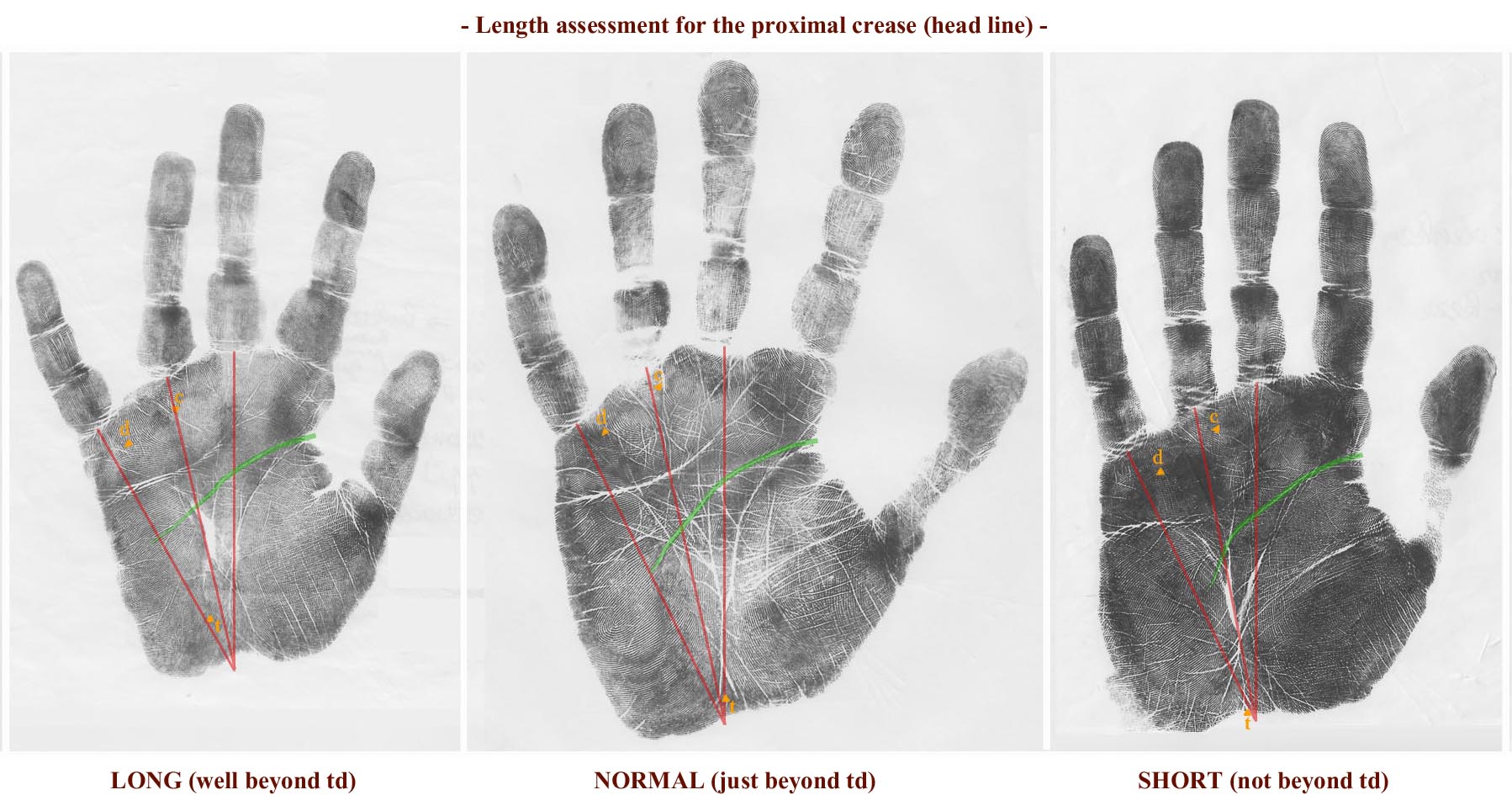
• A+ hand sign c: Short proximal transverse crease in both hands:
In a short proximal transverse crease (= short head line is required not cross the imaginary td line) the termination point is found on the radial side of the imaginary td line: see the right example in the picture above. Interestingly, in 4 out of 5 A+ scorers with A+ hand sign c the distal crease in at least one hand is long (= long heart line); one can derive from this that most of these hands have a quadrangle that is featured with an asymmteric shape: short head line combined with a long heart line!
NOTICE: Hands with a simian crease construction should get excluded for A+ hand signs 3!
• A+ hand sign d: Proximal transverse crease approaches a-triradius:
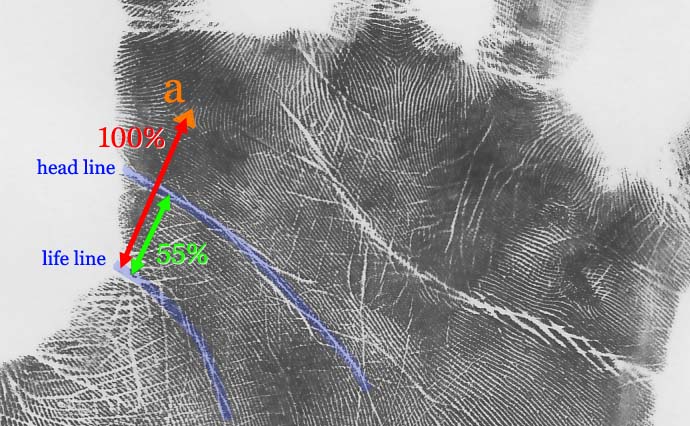 Another interesting phenomonon has been spotted regarding an extraordinary high (distal) located proximal transverse crease - in terms of the vocabulary used in the fields of palmistry this can be described to represent a dissociated head line featured with an extraordinary large distance from the life line, see picture on the right.
Another interesting phenomonon has been spotted regarding an extraordinary high (distal) located proximal transverse crease - in terms of the vocabulary used in the fields of palmistry this can be described to represent a dissociated head line featured with an extraordinary large distance from the life line, see picture on the right.
A fascinating aspect regarding this feature is the parallel with the 'Suwon remnant' in the sense that A+ hand signs 1 & 4 represent both the manifestation of a transverse crease phenomenon located just below the a-triradius!
versus none of the A- scorers (= 0,0%).
Hand features involving the index finger!
The third aspect of the hand that is most likely to provide significant clues regarding the Big Five dimension Agreeableness concerns the index finger + it's palmar zone (obviously, this latter zone became already indirectly notified to represent a significant factor in STEP 1 & 2).
The following two aspects involving the palmar aspect of the index finger bare significance for high scorers (A+):
• A+ hand sign e: Dissociated proximal crease only in right hand [6 out of 66 A+ scorers (= 9,1%), 0 out 35 A- scorers (= 0,0%)];
• A+ hand sign f: ID2 loop both hands (1 vestige is ok) / ID2+3+4 combi in 1 hand [5 out of 66 A+ scorers (= 7,6%), 0 out 35 A- scorers (= 0,0%)].
The following four aspects involving the fingerprints on the index finger bare significance for high scorers (A+):
• A+ hand sign g: on index fingers radial whorl combi (= RW + RW) or radial whorl + concentric whorl combi (= RW + CW) [7 out of 66 A+ scorers (= 10,6%), 0 out 35 A- scorers (= 0,0%)];
• A+ hand sign h: radial loop [RL] on index finger + arch on other finger [5 out of 66 A+ scorers (= 7,6%), 0 out 35 A- scorers (= 0,0%)];
• A+ hand sign i: ulnar loop [UL] on both index fingers + no more than 6x UL on other fingers [6 out of 66 A+ scorers (= 9,1%), 0 out 35 A- scorers (= 0,0%)];
• A+ hand sign j: non-extralimital ulnar loop [UL] on 10 fingers + in both hands: dissociated proximal crease or dissociated axial triradius [4 out of 66 A+ scorers (= 6,1%), 0 out 35 A- scorers (= 0,0%)].
Combining A+ hand signs a to j identify 53 out of 66 A+ scorers (= 80,3%), versus 0 out of 35 A- scorers (= 0,0%).
Other hand sign combinations significant voor A+ scorers!
Five other A+ hand signs have been identified:
• A+ hand sign k: arch (A) or tented arch (UTA/RTA) combined with fingerprint pattern with 2 triradii on at least 1 other finger [9 out of 66 A+ scorers (= 13,6%), 0 out 35 A- scorers (= 0,0%)];
• A+ hand sign l: both palms have the following 3 features: ID4 loop only, proximal crease connected with thenar crease, and normal axial triradius [9 out of 66 A+ scorers (= 13,6%), 0 out 35 A- scorers (= 0,0%)];
• A+ hand sign m: tented arch (UTA or RTA) on middle finger [7 out of 66 A+ scorers (= 10,6%), 0 out 35 A- scorers (= 0,0%)];
• A+ hand sign n: radial pocket loop (RPL) on another than index finger [3 out of 66 A+ scorers (= 4,5%), 0 out 35 A- scorers (= 0,0%)];
• A+ hand sign o: concentric whorl (CW) on same finger in both hands [3 out of 66 A+ scorers (= 4,5%), 0 out 35 A- scorers (= 0,0%)].
Combining A+ hand signs a to o involves 58 out of 66 A+ scorers (= 87,9%), versus 0 out of 35 A- scorers (= 0,0%).
12 hand sign combinations significant for A- scorers!
Finally, the following 12 hand sign combinations have been identified to be signficant for low scorers on the Big Five dimension Agreeableness (A-):
STEP 5a: A- hand signs involing the palmar creases
• A- hand sign p: distal transverse crease falls into proximal transverse crease (without an upward splitting) [5 out of 35 A- scorers (= 14,3%), 0 out 66 A+ scorers (= 0,0%)];
• A- hand sign q: dissociated Sydney line + short distal crease (does not progress beyond zone between index and middle finger) [5 out of 35 A- scorers (= 14,3%), 0 out 66 A+ scorers (= 0,0%)];
• A- hand sign r: thenar line progresses beyond axial triradius (but not via a splitting outgoing branch) + axial line is located at the ulnar side of the imaginary tb line [7 out of 35 A- scorers (= 20,0%), 0 out 66 A+ scorers (= 0,0%)];
• A- hand sign s: short distal crease (does not progress beyond middle finger + not beyond imaginary ab line) [7 out of 35 A- scorers (= 20,0%), 0 out 66 A+ scorers (= 0,0%)];
STEP 5b: A- hand signs involving the dermatoglyphics:
• A- hand sign t: arch fingerprint on index finger without an arch on the thumb + without any radial fingerprint patterns + without ulnar loop on hypothenar [6 out of 35 A- scorers (= 17,1%), 0 out 66 A+ scorers (= 0,0%)];
• A- hand sign u: hypothenar radial loop + index finger radial loop or complex radial pattern + path of a-line path is high (does not enter the hypothenar radial loop) [5 out of 35 A- scorers (= 14,3%), 0 out 66 A+ scorers (= 0,0%)];
• A- hand sign v: empty palm (= no palmar loops or whorls) + shifted axial triradius (t' or t") [4 out of 35 A- scorers (= 11,4%), 0 out 66 A+ scorers (= 0,0%)];
• A- hand sign w: fingerprint on pinky is an arch, double loop or concentric whorl [4 out of 35 A- scorers (= 11,4%), 0 out 66 A+ scorers (= 0,0%)];
• A- hand sign x: multiple complex fingerprint patterns involving both hands only present on different fingers [4 out of 35 A- scorers (= 11,4%), 0 out 66 A+ scorers (= 0,0%)];
• A- hand sign y: fingerprint combi involving an ulnar double loop (UDL) or ulnar pocket loop (UPL) on two fingers that are not located next to each other [3 out of 35 A- scorers (= 8,6%), 0 out 66 A+ scorers (= 0,0%)];
• A- hand sign z: both index fingers have a radial fingerprint pattern of which at least one is a radial loop + at least on palm has a ID3 + ID4 combination [3 out of 35 A- scorers (= 8,6%), 0 out 66 A+ scorers (= 0,0%)];
• A- hand sign +: at least 9 extralimital fingerprint patterns [3 out of 35 A- scorers (= 8,6%), 0 out 66 A+ scorers (= 0,0%)];
• A- hand sign *: 10 ulnar loops including no more than 3 extralimital patterns + ID3 is missing + hypothenar pattern is missing + thenar pattern is missing + proximal crease connected with thenar crease in at least 1 hand [5 out of 35 A- scorers (= 14,3%), 0 out 66 A+ scorers (= 0,0%)];
STEP 5c: A- hand sign involving the index finger:
• A- hand sign #: constellation in at least 1 hand involving a low set index finger with length that falls short relative to all other fingers + a low set a-triradius (5 out of 6 criteria must be present: [1] 2D:1D < 1,15; [2] 2D:3D < 0,90; [3] 2D:4D < 0,93; [4] 2D:5D < 1,20; [5] imaginary ac line is directed proximal towards radial side; [6] c-triradius has wider distance than b-triradius from the imaginary ad line) [3 out of 35 A- scorers (= 8,6%), 0 out 66 A+ scorers (= 0,0%)];
Combining A- hand signs p to # (step 5a, 5b & 5c) involve 35 out of 35 A+ scorers (= 100,0%), versus 0 out of 66 A+ scorers (= 0,0%). And the combination of the 15 A+ hand signs and the 12 A- hand signs make it possible to separate both groups from each other. An overview of the distribution of A+ hand signs & A- hand signs in all 101 subjects is presented inside the table below.
in 66 Agreeableness high scorers (A+) and 35 Agreeableness low scorers (A-):

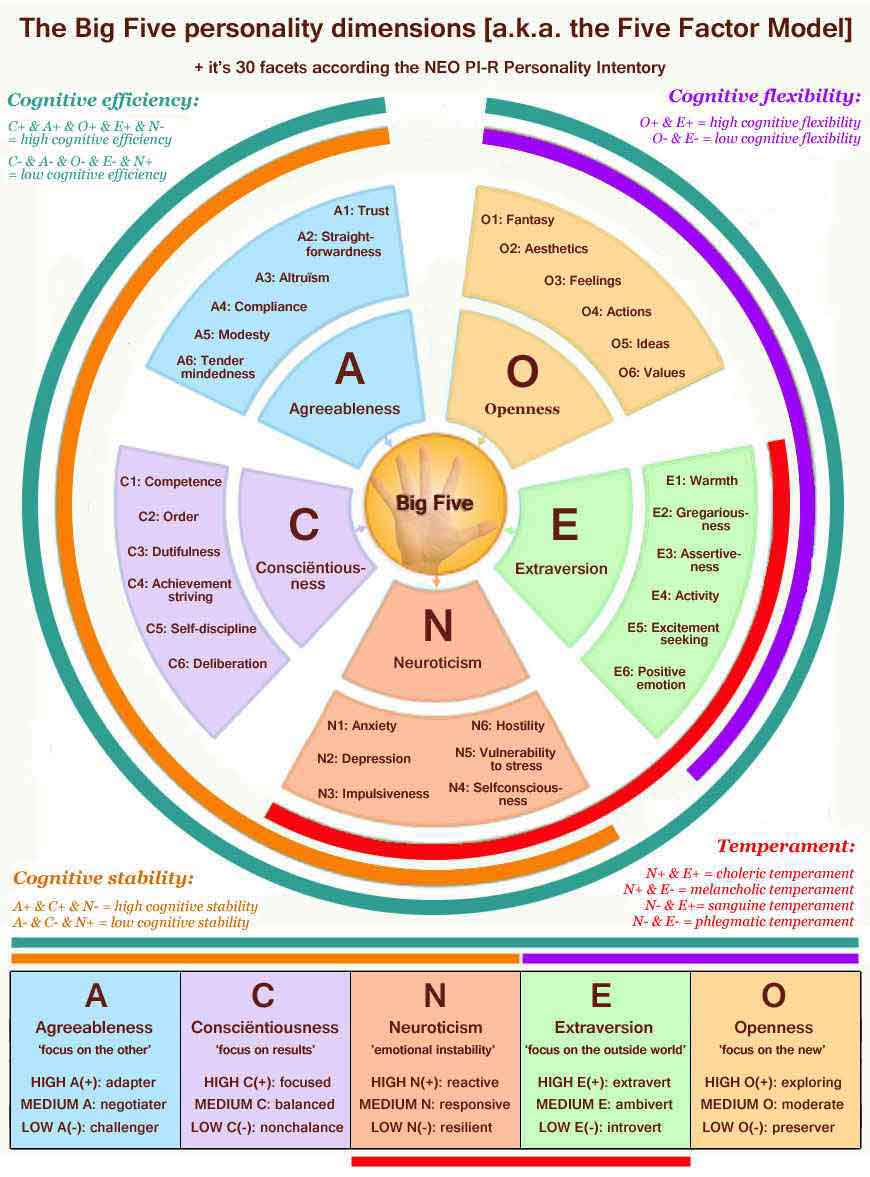
Agreeableness represent a dimension of the Big Five model, a.k.a. the 'Five Factor Model' (FFM).
The model is designed to describe the full 'color-spectrum' of a personality, including:
the classic temperaments, cognitive stability & cognitive flexibility.
Final notification: case studies will become available in the near future; meanwhile you might want to
explore the other four Big Five dimensions Conscientiousness, Extraversion, Neuroticism & Openness!
All Big Five hand charts are presented together inside the article:
Hand sign constellations in the Big Five personality dimensions.
|
|
© COPYRIGHT 2002-2017: |
